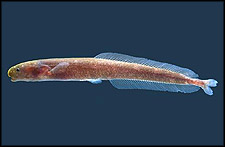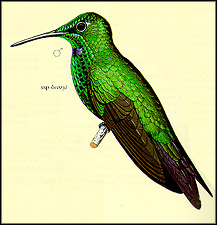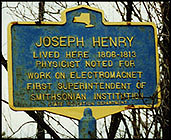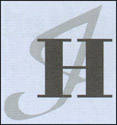 Return to Home Page HENRY NAMESAKESBy Frank MillikanHistorian, Joseph Henry Papers Project Images scanned by Jennifer Nichols Program Assistant, Institutional History Division Over the years, people have honored Joseph Henry by naming a variety of things after him, including a laboratory, a professorial chair, ships, and even a mountain range. Featured below is a selection of Henry namesakes, given in chronological order. Note that the naming began during Henry's own lifetime (1797-1878). (Please click on photographs for larger images.) Be sure to keep checking this list, which we originally compiled in 1999. During the course of our research, we continue to find Henry namesakes and learn more about them. Our most recent addition to the list, heliodoxa jacula henryi, was made in May 2001. We welcome comments, suggestions, and corrections. ca. 1854 Schooner Joseph Henry
ca. 1855 Cape Henry Henry backed several expeditions to the North Pole from the 1850s to the 1870s. One of the most famous of these was the Second Grinnell Expedition (1853-1855), organized and led by surgeon/explorer Elisha Kent Kane. Although the expedition failed in its main mission--to locate the missing polar explorer Sir John Franklin--it did gather meteorological and other scientific data while penetrating previously unexplored regions. Kane named scores of coastal bays, inlets, and other geographical features. One of these, a small projection at 79° north latitude off the coast of Ellesmere Island, he named Cape Joseph Henry (now shortened to Cape Henry and not to be confused with the Cape Joseph Henry described below). Kane thereby acknowledged Henry for giving his endorsement to the expedition in an influential letter to the secretary of the navy and for providing Kane with scientific instructions and instruments.
In the course of his explorations, Kane sketched numerous arctic scenes, from which some three hundred engravings were made and published in his two-volume narrative of the expedition. Unfortunately, Kane does not provide a sketch of Cape Henry. The engraving at right is from Kane's depiction of icebergs near Life Boat Cove, south of Cape Henry. Here is Kane's evocative description: "A grander scene than our bay by moonlight can hardly be conceived.... It is a landscape such as Milton or Dante might imagine,--inorganic, desolate, mysterious. I have come down from deck with the feelings of a man who has looked upon a world unfinished by the hand of its Creator."2 ca. 1860-61 Henry Island Isaac I. Hayes, who had served as surgeon to Kane's Second Grinnell Expedition, commanded his own arctic expedition in 1860-1861. In a lecture given at the Smithsonian shortly after his return, he expressed gratitude "to the Smithsonian Institution for the liberal support which was rendered by it to the expedition, not only by its contribution of scientific apparatus, but through the encouragement which was given towards effecting its organization by the influence of the distinguished gentleman [Henry] who is the principle executive officer of the establishment." In his book, The Open Polar Sea: A Narrative of a Voyage of Discovery Towards the North Pole, Hayes noted, "The Smithsonian furnished a good supply of barometers and thermometers, besides other apparatus not less important, and also spirits, cans, and other materials for the collection and preservation of specimens of Natural History."
North of the cape Kane had named after Henry, Hayes discovered a sound separating Grinnell Land from Ellesmere Island. In the mouth of the sound there appeared to be two large islands; he named the southernmost one after Henry and the other one after Alexander Dallas Bache (now Bache Peninsula). Henry Island is located at 79° north latitude, and is not to be confused with the Henry Island located much further south near Cape Breton, Nova Scotia (which has no apparent connection to Joseph Henry).3 1862 Isichthys henryi
Isichthys henryi is one of the so-called electric fishes, which generate a weak electric field to detect objects in their environment. Gill probably relished the opportunity to name this particular fish after Henry, given Henry's pioneering work in electromagnetism. The holotype (the specimen from which the species was described) is preserved at the National Museum of Natural History, Smithsonian Institution. A modern entry on the species notes that it is a freshwater fish that inhabits the West African coastal plains of Guinea, Sierra Leone, and Liberia, and the coastal rivers of Nigeria.4 1866 Heliodoxa jacula henryi
ca. 1869 Henry Mountains
For more on the Henry Mountains, see footnote 6 and these web sites: The Henry Mountains and The Henry Mountains Wilderness. ca. 1871 Cape Joseph Henry
The point sighted by Hall just before his death was Cape Joseph Henry, located at 82° north latitude. The cape, though well short of the North Pole, would become an important depot from which subsequent expeditions would venture forth into the unknown region called "The Great Frozen Sea." The commander of a British ship attempting to explore this region in 1875 wrote: "Beyond Cape Joseph Henry all was conjecture.... No land of any description could be seen to the northward--nothing but the rugged pack. So formidable and compact appeared this icy barrier that it seemed to stand out bold and resolute in its strength, effectually setting at defiance the puny efforts of man to penetrate its solidity, saying, as it were, 'Thus far shalt thou go, and no farther.'"
Hall's premature death has left us with little evidence about his naming of the cape. Presumably he was grateful for Henry's critical support of the expedition, particularly for the letter of endorsement he wrote, at Hall's request, on March 12, 1870, to the chairman of the U.S. House appropriation committee. Henry also, in his capacity as president of the National Academy of Sciences, chaired the committee that devised the expedition's scientific program. One possibly fateful decision Henry made was to choose as chief scientist for the expedition the German physicist, naturalist, and physician Emil Bessels. Although a contemporary investigation ruled that Hall died of natural causes, in 1968 Hall's biographer journeyed to the grave site to exhume Hall's body from the frozen ground. An autopsy confirmed arsenic poisoning. While the poisoning may have been unintentional, murder was a strong possibility. Hall's biographer considered Bessels a prime suspect.7 1872 Joseph Henry Chair of Physics
The scene at right is from a mural painted by Gifford Beal (Princeton class of 1900) in 1946, for the bicentennial of Princeton's founding. The mural, located in the lobby of the John C. Green School of Engineering, depicts Henry demonstrating electrical phenomena. The backdrop is Princeton's Philosophical Hall, where Henry taught and performed many electrical experiments, including telegraphic ones.8 1879 Henry medal
In January 1967, the Smithsonian's Board of Regents proposed to use the Henry medal to recognize distinguished service to the institution. Since that time, recipients of the medal have included a Smithsonian secretary, Charles Abbot, an astrophysicist, Fred Whipple, an anthropologist, T. Dale Stewart, and a U.S. vice-president and Smithsonian regent, Hubert H. Humphrey. In 1997, on the occasion of the bicentennial of Henry's birth, the medal was awarded to physicist Frederick Seitz, a long-time supporter of the Henry Papers Project and chair of its advisory committee.9 1880 Tender Joseph Henry
Lighthouse tenders were ships that serviced and maintained lighthouses. They were needed because lighthouses were often situated in isolated areas, where access to supplies was limited for keepers and their families. Some tenders were also used to maintain the coastal buoy system. "Through storm, darkness, and sunshine," a government official once said, lighthouse tenders "do their work for humanity without any boasting, without any advertising, with none to trumpet their praises, and with only their own sense of duty to guide them." The Joseph Henry was one of only a few lighthouse tenders used along western rivers. It plied a 2,500-mile stretch along the Mississippi and Missouri Rivers for more than forty years. The model pictured here mistakenly indicated the ship belonged to the sixteenth lighthouse district; it actually served the fifteenth district.10 ca. 1881 Henry-Baird Column
In July 1880, a party of Smithsonian officials toured the caverns at the invitation of the discoverers and proprietors. The Smithsonian party included chief clerk William J. Rhees, geologist Charles A. White, photographer T. W. Smillie, as well as two ethnologists, an archaeologist, and a chemist. Their tour lasted for two days and resulted in a twelve-page report in the Annual Report of the Smithsonian Institution for the Year 1880. Subsequently a 1,000-pound stalactite was removed and transported to the Smithsonian. In 1882, Horace Hovey, considered an authority on caves, published a map of Luray Caverns in his Celebrated American Caverns. Hovey himself named most of its halls, rooms, and objects ("Christening is my business," he reportedly said). An exception was the Henry-Baird Column, which is the name used on Hovey's map. It was given this name by a small natural history society from Reading, Pennsylvania. A somewhat cryptic explanation appeared in the 1882 edition of S. Z. Ammen's History and Description of the Luray Cave, in which Ammen discusses the "Double Column" and appends this note: "Recently dedicated by the Reading Society of Natural Sciences, under the name 'Henry-Baird Column,' to the late Prof. Joseph Henry, the first Secretary, and Prof. Spencer F. Baird, the present Secretary of the Smithsonian Institution at Washington." The Henry-Baird Column, as described by Hovey in an Encyclopedia Britannica entry in 1911, "is made of two fluted pillars side by side, the one 25 and the other 60 ft. high, a mass of snowy alabaster." As characterized by Ammen, they are "both of immense size and symmetrical in shape." A promotional article in Frank Leslie's Illustrated Newspaper in 1879 claimed that they dwarfed other columns in Giant's Hall and "will rivet the attention of tourists for hours." Today the stalagmites are known simply as the Double Column.11 1885 Joseph Henry trolley
1893 The "henry"
1943 SS Joseph Henry
1958 Joseph Henry Elementary School
ca. 1966 Joseph Henry Laboratories of Physics
Statues by Daniel Chester French of Henry and Benjamin Franklin are fittingly paired at the front entrance of Palmer Laboratory (only the Henry statue is shown here). Henry was often compared to Franklin because of their pioneering experiments with electricity.16 1993 Joseph Henry Press
Correction: An earlier version of "Henry Namesakes" listed an entry for 1873, the
schooner Joseph Henry. The entry read in part:
"In 1873, an official of the U.S. Pilot & Coast
Wrecker of Harlem, New York, informed Henry that a clipper schooner
under construction in Maine would bear his name:
'Your long and tried devotion to our beloved country and its scientific
advancement, as well as your Patriotism, christian virtues and benevolence has endeared
you to the American people and rendered your name a Household theme throughout our land.'
We have recently identified Henry's letter of reply, however, which indicates that this action was never taken.
The official had informed Henry that it was customary for the honoree to furnish,
at a cost of $100, flags for the vessel bearing his name. Henry replied,
"I must decline the honor proposed, not that I hold it cheaply or that I am actuated
by any narrow feeling in regard to the expenditure of money, but in justice to my
family and the position I hold as the Director of this
Institution."18
Please send comments to Marc Rothenberg. |
















